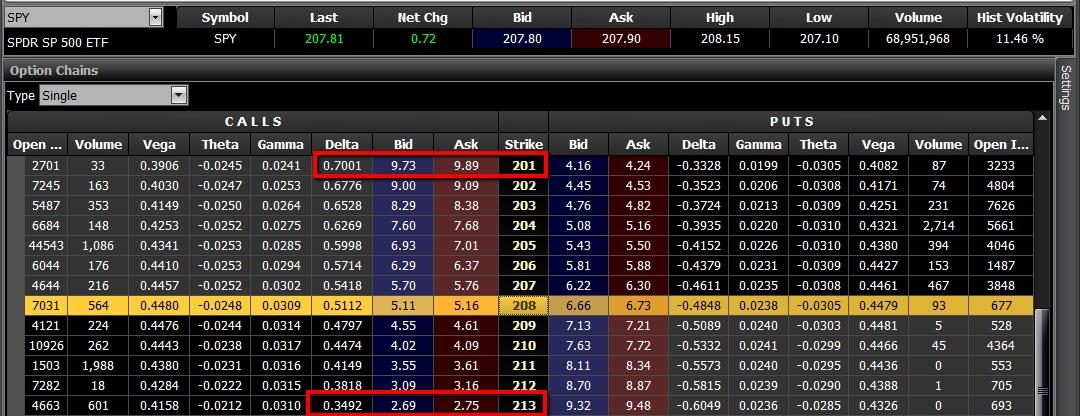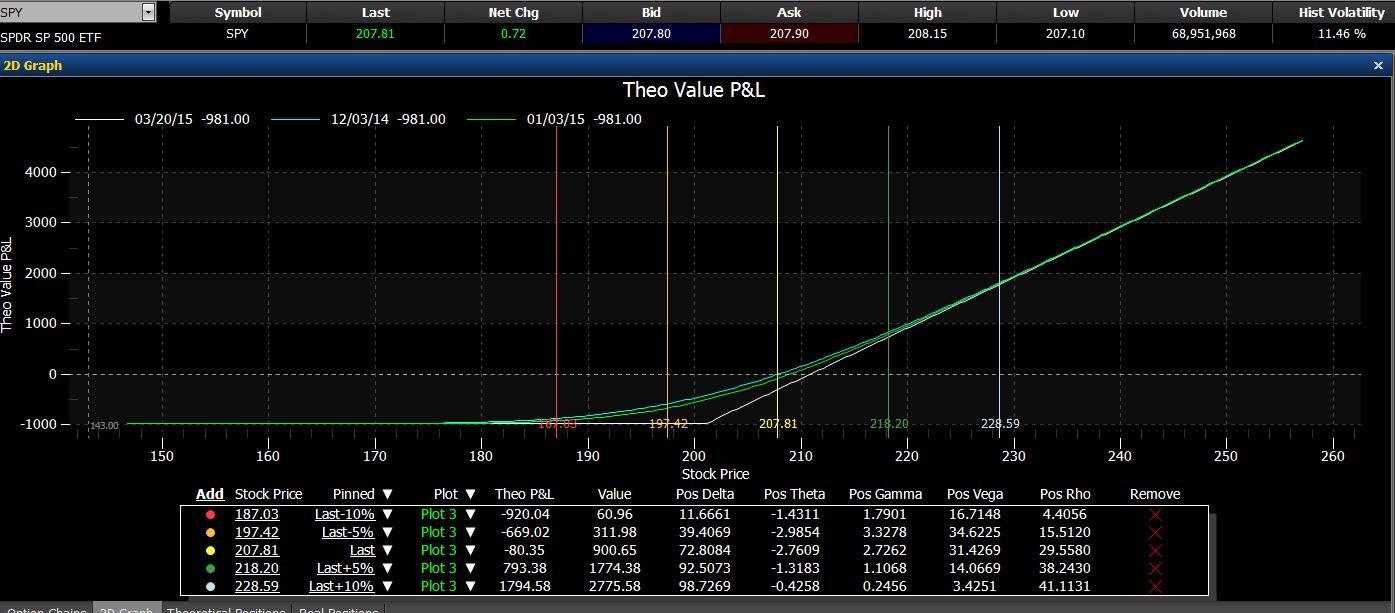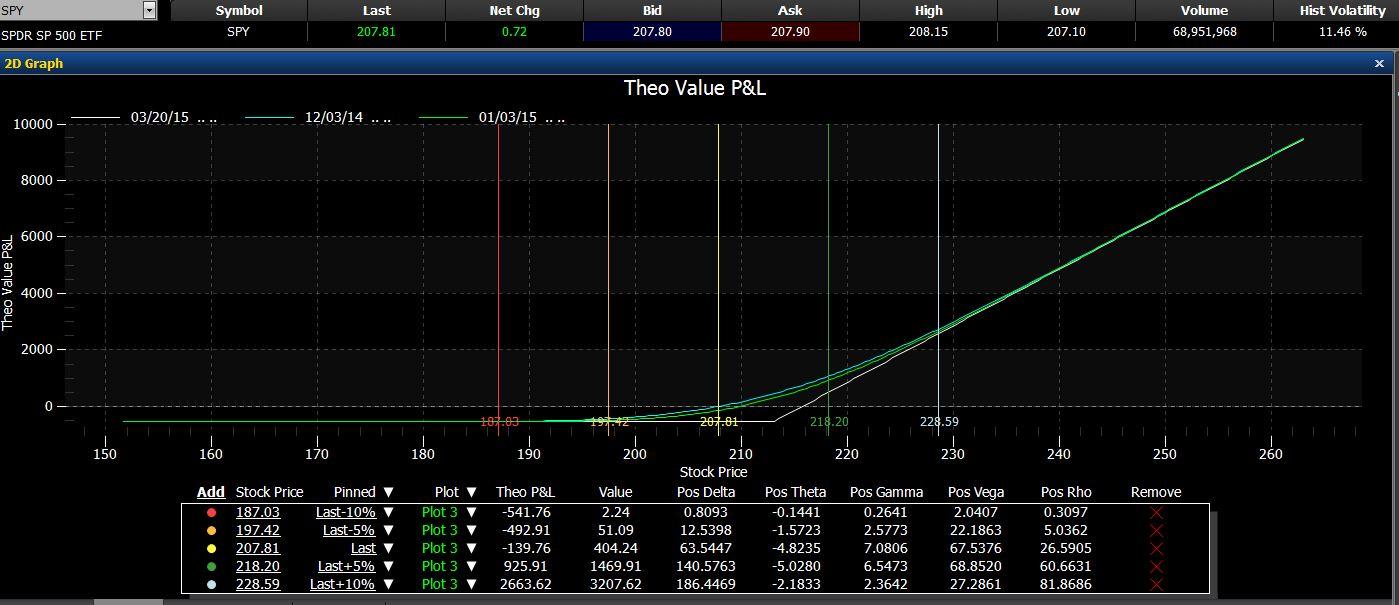Periodically I use this column to answer questions sent by readers. Here’s an interesting one I received recently:
As a bullish position, can you compare the advantages and disadvantages of buying one contract of an in-the-money Call option with a Delta of 70, vs buying two out-of-the-money contracts with a Delta of 35 each (also a Delta of 70 total)?
This is a sophisticated question. To answer it, we have to explain that Delta is the percentage of the next one-point price movement of the stock that will be experienced by the option. So the value of a call option with a Delta of 70 would rise by 70 cents, if the underlying stock went up by one dollar. And if instead of that call option, we select one with a Delta of 35, but buy two of them, then that position would also profit by 70 cents ($.35 times 2) for the next one-dollar move up in the stock. Are these positions equivalent?
The answer is that they are equivalent only for the next one-dollar move in the stock, and only if that one-dollar move happens today, with no change in market expectations. In other words, no they are not.
Now let’s look at the pros and cons of each one.
As an example, we’ll use call options on SPY, the exchange-traded fund that tracks the S&P 500 index.
On December 3, 2014, SPY closed at $207.89 – a new all-time closing high, by the way. On that day, a partial option chain for the March 2015 options looked like this:
Figure 1 – SPY March options as of December 3, 2014
>Notice the two red rectangles above.
The Bid and Ask prices for the 201-strike calls, with a delta of .7001, were at $9.73 and $9.89. The midpoint between the Bid and Ask would be $9.81. The gold highlight at the 208 strike shows the dividing line between calls that were in the money like this one, and calls that were out of the money.
The Bid and Ask prices for the 213-strike calls, meanwhile, with a delta of .3492 each, were at $2.69 and $2.75, with a midpoint therefore at $2.72.
Two of the out-of-the-money 213 calls could have been bought for $272 X 2, or $544. This was considerably cheaper than the cost of one 201-strike in-the-money call, at $ 981.
Each position (one of the 201 calls, or two of the 213 calls) would show a profit of $70 if SPY’s price increased by $1.00 per share today.
Now let’s look at a P/L diagram for each position. On each of the diagrams below, I’ve placed markers at the current price, at 5% and 10% below the current price, and at 5% and 10% above. This is so that we can compare different scenarios.
Here is the diagram of the one 201 call:
Figure 2 – P/L diagram for one SPY 201 March call
And here is the diagram for a position consisting of two 213-strike calls:
Figure 3 – P/L diagram for two March 213 SPY calls
Note that I selected the March call options, three months out; and I’m comparing the results of the two positions as of one month from now, on January 3, 2015. The comparison would be much different if made as of the expiration date, which is how the standard P/L diagram works. In that case, the break-even price on the 213 calls would be so high that it would be nearly impossible to make money on them, and that possibility would probably be dismissed.
But if each position is only held during the time in its life when its time value is not deteriorating too rapidly, as shown here, then a different picture emerges.
The two 35-delta calls make more, or lose less, at any SPY price level, than the single 70-delta call, assuming no change in Implied Volatility; except where SPY is unchanged a month from now. In that case, the 35-delta calls lose $139 compared to the 70-delta call’s $80 loss. So far, a definite win for the 35-delta calls.
One potential disadvantage of the 35-delta calls is that they have a higher Vega value, meaning that they will suffer more in case Implied Volatility drops. If SPY should continue to advance, a drop in IV is likely. This would hurt the 35-delta calls more. A drop in IV from its current 12% back down to the recent lows of 8%, a 4-point drop, would cost the 70-delta call somewhere between $3-30, depending on the price of SPY, while hurting the 35-delta calls by anywhere from $2-69. Close enough to be called a tie.
Along with the somewhat higher Vega exposure, the two 35-delta calls also have higher negative Theta, meaning that after this first 30 days, they would suffer more from time decay. Since we would have no intention of holding them longer than 30 days, time decay after that would not matter to us, so we can disregard this.
In the end, it turns out that there are definite advantages to using the two out-of-the money options, as long as we do not hold them after 30 days. Most comparisons are equal or better than the one 70-delta call, and the cost is considerably less. The key is that we must not hold them close to their expiration date, where Theta would overtake their advantages.
Being able to compare different positions requires good software tools, as well as the ability to interpret the information they provide. The software is available from multiple sources – these graphs happen to be from Tradestation, and others exist.
For the skill to interpret them, call your nearest center and ask about our Professional Options Trader class.
This content is intended to provide educational information only. This information should not be construed as individual or customized legal, tax, financial or investment services. As each individual's situation is unique, a qualified professional should be consulted before making legal, tax, financial and investment decisions. The educational information provided in this article does not comprise any course or a part of any course that may be used as an educational credit for any certification purpose and will not prepare any User to be accredited for any licenses in any industry and will not prepare any User to get a job. Reproduced by permission from OTAcademy.com click here for Terms of Use: https://www.otacademy.com/about/terms
Editors’ Picks
EUR/USD extends gains above 1.0700, focus on key US data

EUR/USD meets fresh demand and rises toward 1.0750 in the European session on Thursday. Renewed US Dollar weakness offsets the risk-off market environment, supporting the pair ahead of the key US GDP and PCE inflation data.
USD/JPY keeps pushing higher, eyes 156.00 ahead of US GDP data

USD/JPY keeps breaking into its highest chart territory since June of 1990 early Thursday, recapturing 155.50 for the first time in 34 years as the Japanese Yen remains vulnerable, despite looming intervention risks. The focus shifts to Thursday's US GDP report and the BoJ decision on Friday.
Gold closes below key $2,318 support, US GDP holds the key

Gold price is breathing a sigh of relief early Thursday after testing offers near $2,315 once again. Broad risk-aversion seems to be helping Gold find a floor, as traders refrain from placing any fresh directional bets on the bright metal ahead of the preliminary reading of the US first-quarter GDP due later on Thursday.
Injective price weakness persists despite over 5.9 million INJ tokens burned

Injective price is trading with a bearish bias, stuck in the lower section of the market range. The bearish outlook abounds despite the network's deflationary efforts to pump the price.
US Q1 GDP Preview: Economic growth set to remain firm in, albeit easing from Q4

The United States Gross Domestic Product (GDP) is seen expanding at an annualized rate of 2.5% in Q1. The current resilience of the US economy bolsters the case for a soft landing.
RECOMMENDED LESSONS
Making money in forex is easy if you know how the bankers trade!
Discover how to make money in forex is easy if you know how the bankers trade!
5 Forex News Events You Need To Know
In the fast moving world of currency markets, it is extremely important for new traders to know the list of important forex news...
Top 10 Chart Patterns Every Trader Should Know
Chart patterns are one of the most effective trading tools for a trader. They are pure price-action, and form on the basis of underlying buying and...
7 Ways to Avoid Forex Scams
The forex industry is recently seeing more and more scams. Here are 7 ways to avoid losing your money in such scams: Forex scams are becoming frequent. Michael Greenberg reports on luxurious expenses, including a submarine bought from the money taken from forex traders. Here’s another report of a forex fraud. So, how can we avoid falling in such forex scams?
What Are the 10 Fatal Mistakes Traders Make
Trading is exciting. Trading is hard. Trading is extremely hard. Some say that it takes more than 10,000 hours to master. Others believe that trading is the way to quick riches. They might be both wrong. What is important to know that no matter how experienced you are, mistakes will be part of the trading process.



